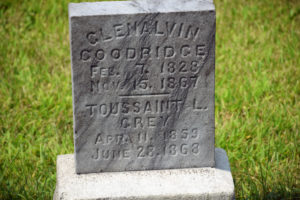Obituaries can be a source of valuable information for people wanting to know about family members or other people they”'re interested in, but not all obituaries provide the same information or even close to it. Â
The style and substance of obituaries has changed over time. During the late 1800s up until about the middle of the 20th century, obituaries functioned as death announcements and mostly offered details about funeral and burial arrangements but little else. More recent obituaries tend to focus on achievements and accomplishments and connections to family and friends, sometimes in the newspaper, but increasingly in social media.
In the 1860s, obituaries often told more about someone”'s character or beliefs. Sarah Dickey died in childbirth on Dec. 4, 1868, at the age of 41. She and her husband came to St. Anthony around 1865. He worked as a wheelwright. Her obituary ran on the front page of the Minneapolis Tribune on Dec. 9, 1868:
DIED ”“ In Minneapolis, December 4th, Mrs. Sarah R. Dickey, wife of Mr. William Dickey.
The deceased, during a residence of somewhat more than a year, had greatly endeared herself to the friends and acquaintances she had formed. Her manners were affable and winning; her conversation indicated culture; her tastes were refined and elevated; her mind was active and fond of the investigation of truth; her religious sensibilities were quick, and conversation upon religious themes was to her a source of evident delight. The loss to her family, to her circle of friends, and to the church with which she worshiped is great. The experience of extreme suffering had made her covet the “rest for the weary.”
Some obituaries, especially those written for children, included poetry. Toussaint L”'Ouverture Grey was born on April 11, 1859, and is said to have been the first African-American child born in St. Anthony. His parents were political activists, and his father was described as the “first resident barber in St. Anthony.”Toussaint”'s obituary ran on the front page of the Minneapolis Tribune on July 2, 1868:
DIED ”“ In this city, June 28th, of heart disease, Toussaint L”'Overture Grey, second son of R. T. and E. O. Grey, aged 9 years, 2 months and 17 days.
A devoted son and loving brother, his death will leave a void in the family circle, never to be filled. A good child, loving his Sabbath school and his God, he was willing to die, and asked his family to meet him in Heaven. He leaves a large circle of friends to sympathize with his parents over his early death.
He has gone to glory before us
He turns and waves his hand
Pointing to glory over us,
In that bright and happy land.
The Minneapolis Tribune”'s announcement of Lawrence (Lorenzo)Taliaferro Prescott”'s death is sparse considering the fact that he was the son of one of Minnesota”'s best-known territorial pioneers. He was the son of Philander Prescott, one of the casualties of the 1862 Dakota Conflict, and Mary (Spirit of the Moon) Prescott, the daughter of a Dakota tribal elder. Lorenzo served with the first Minnesota Heavy Artillery during the Civil War until he received an honorable discharge for a medical disability. While serving on the East Coast, he contracted malaria and his death is thought to have been caused, at least in part, by an overdose of quinine, the preferred treatment for malaria at the time. Lorenzo returned to Minnesota and married Marion Robertson Hunter, the granddaughter of Grey Cloud. He worked as an interpreter in one of the relocation camps in Nebraska, but returned to his sister”'s home in Shakopee when his health failed. The following announcement appeared in the Minneapolis Tribune on Jan. 6, 1869, three days after he died from ulcers. He was 30 years old.
“Mr. Prescott was well educated, a young man of good character and habits and until quite recently was employed as interpreter, at the Indian agency near Omaha. Failing health necessitated his resignation of that position, and he returned home to die.”
Lorenzo Prescott is buried near his parents on what the Tribune described as “the old homestead, near Minnehaha.” That appears not to have been the case since his parents had been buried in the family”'s plot at Layman”'s cemetery almost two years earlier.
Despite the occasional error or misunderstanding, obituaries are a valuable source of information and have preserved some sense of what people were like. Not just how and when they died, but how they lived.













Some Pioneer cemetery tombstones appear on the findagrave web site. A Ken Wright posted my grandfathers.